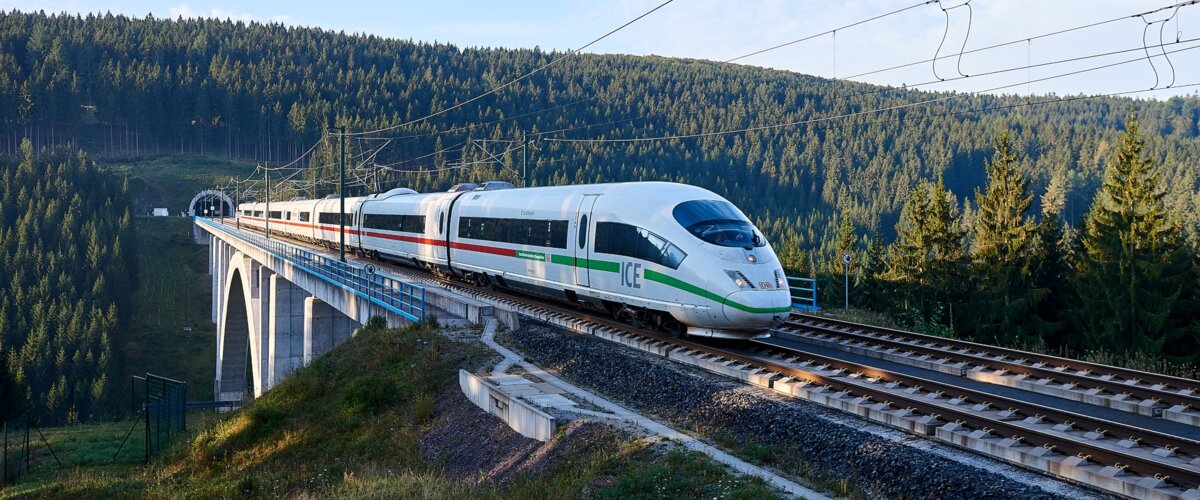Transporting more people and goods by rail is an important lever for achieving German and European climate protection goals. After all, rail is already one of the most climate-friendly modes of transport today. To secure the future viability of Deutsche Bahn and strengthen its own business model, DB is expanding this competitive advantage.
Sustainability is not only of central importance for Deutsche Bahn's financial development and refinancing. It is also a key promise made by DB to its customers, society, and the state. By transporting goods and passengers on environmentally friendly railways, DB also supports its customers in achieving their own climate protection goals.
With the ecological transformation of Deutsche Bahn, we are securing DB's future viability and supporting our customers in achieving their own climate protection goals.
Deutsche Bahn has therefore anchored the green transformation centrally in its Strong Rail corporate strategy and is driving it forward in a focused manner across all business areas in five ecological fields of action.
In view of the most pressing challenges posed by climate change, Deutsche Bahn is focusing on climate protection and climate resilience. At the same time, DB is working with its stakeholders to promote the responsible use of resources, protect biodiversity, and reduce noise pollution for local residents.
Climate resilience
As an operator of critical infrastructure and a large-scale organization, DB is particularly affected by the current and future consequences of climate change. That is why Deutsche Bahn is preparing intensively for increasing extreme weather events and is further developing its climate resilience management both strategically and operationally.
By taking active measures, DB is not only complying with regulatory and legal requirements. With its group-wide and cross-business resilience management, DB is also focusing on safer infrastructure, more resilient buildings, more reliable vehicles, and protecting its customers and employees from the consequences of climate change.
Climate protection
Rail transport is already one of the most climate-friendly forms of mass transportation. To strengthen this competitive advantage and secure its own business model, Deutsche Bahn aims to become climate neutral by 2040 and has committed to reducing its greenhouse gas emissions across the entire value chain to net zero.
DB's climate protection goal is of central importance for the company's financial development and secures Deutsche Bahn's future viability. By transporting goods and passengers on environmentally friendly railways, DB also supports its customers and the state in achieving their own climate protection goals.
On its path to net-zero emissions, DB has defined four specific levers to drive the decarbonization of the Group: increasing the share of renewable energies, phasing out diesel and electrification, increasing energy efficiency, and using low-emission building materials.
Resource protection
On its way to net-zero emissions by 2040, Deutsche Bahn is consistently reducing its greenhouse gas emissions. At the same time, DB is investing heavily in reliable infrastructure in the coming years. To minimize emissions caused by construction activities, DB is therefore also focusing on low-emission building materials and partnerships such as the Zukunftsinitiative Bahnbau (ZIB).
By using low-emission building materials, DB is contributing to its climate protection goals while also laying the foundations for establishing a circular economy within the Group. Climate protection and resource conservation are also being brought together through the increased use of recycled materials and a recycling rate of at least 95 percent.
This underscores DB's overall commitment to a circular economy by 2040 and the introduction of circular business models – subject to economic, legal, and technological conditions.
Environmental protection
After operational safety, protecting the environment and nature is a high priority for Deutsche Bahn – from planning and construction to the operation and maintenance of infrastructure. For example, DB is developing a net gain vision with regard to biodiversity and is working to better reconcile railway operational requirements with nature conservation.
To counteract the loss of biodiversity, DB acts in accordance with the principle of mitigation hierarchy: first, negative impacts on nature must be avoided as far as possible. Where interventions are unavoidable for operational and operational safety reasons, measures are taken to mitigate these impacts. Any remaining adverse effects are compensated for by appropriate mitigation measures, such as the creation of compensation and replacement areas recognized under nature conservation law.
Noise reduction
Transporting goods and passengers by rail is not a silent process. In order to reduce noise and thus increase acceptance of rail transport, Deutsche Bahn has therefore set itself the goal, together with the federal government, of reducing the burden on local residents.
By 2030, Deutsche Bahn and the federal government aim to reduce rail noise for more than 800,000 residents as part of their noise abatement program. That is more than half of all residents currently living along noisy rail lines. And by 2050, rail noise will be reduced for all affected residents.
